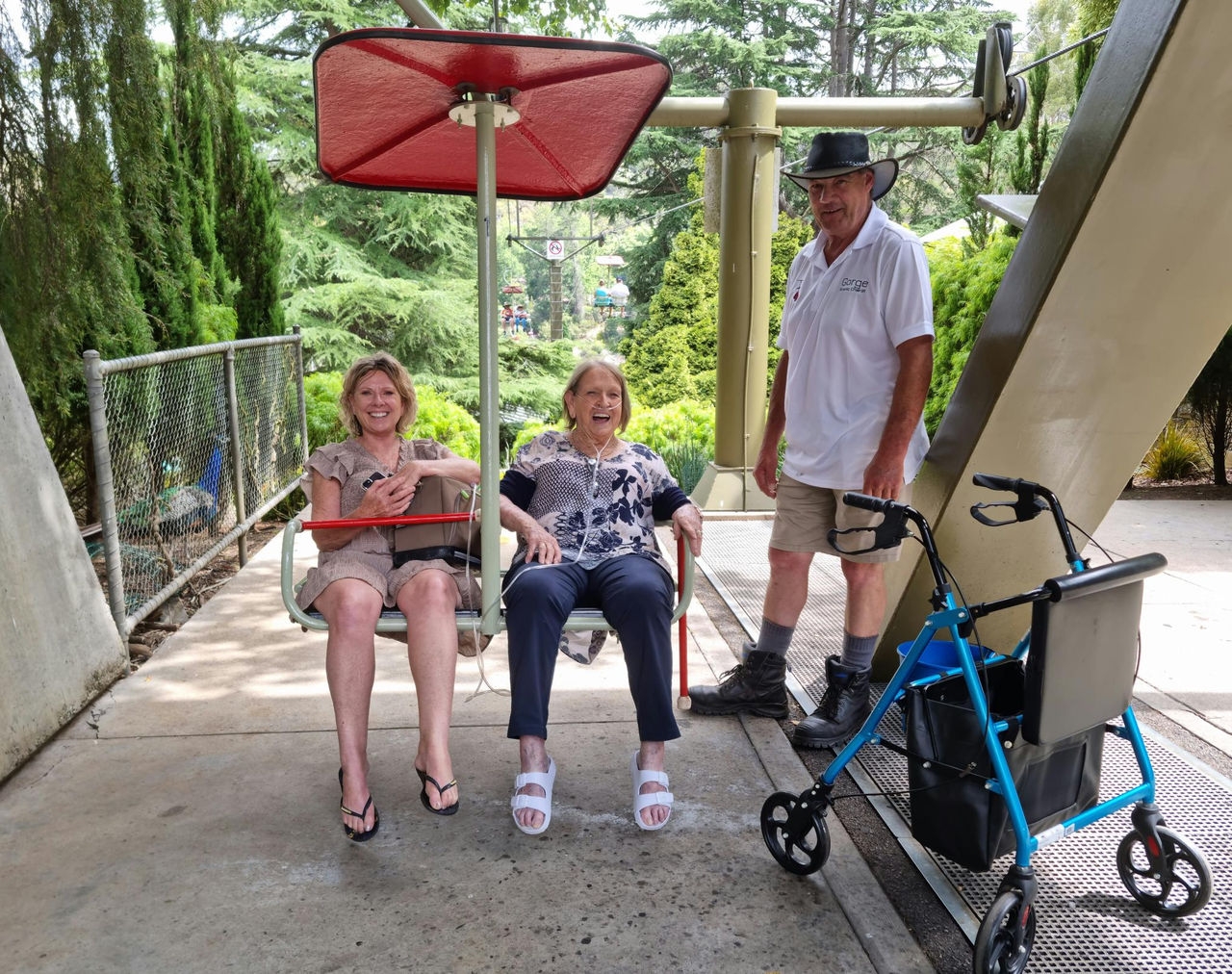The government is now operating in accordance with the Guidance on Caretaker Conventions, pending the outcome of the 2025 federal election.
Taking off on Tasmania’s accessible Gorge Scenic Chairlift
The Gorge Scenic Chairlift ensures visitors of all abilities can enjoy the view over Cataract Gorge Reserve.
Chairlifts are more often linked with skiing than accessible tourism. The Gorge Scenic Chairlift in Launceston, northern Tasmania, is different.
This chairlift sails at a gentle speed over the city’s Cataract Gorge Reserve. Attendants can pause it – and regularly do – to welcome on board people with limited mobility.
The main Basin Road station has an accessible entrance. Wheelchair users can leave their chairs while they ride to the higher Cliff Grounds station and back. The 20-minute return journey runs above the South Esk River and the gorge’s First Basin.
An adventure for all
Cataract Gorge Reserve has been a drawcard for more than a century. Its natural beauty and Victorian-era gardens make it popular with all ages. It’s famous for its tearooms, band rotunda, peacocks and historic suspension bridge.
The gorge is laced with hiking trails, some of them steep.
‘But for people who can’t walk long distances, the chairlift is a perfect way to tour it,’ says chairlift owner Jo Larter. ‘It means they can do something that everybody else can do, which we just love.’
Accessibility a THRIVE 2030 priority
Improving the accessibility of tourism destinations and experiences is a priority of THRIVE 2030, Australia’s visitor economy strategy. The Larters were there early. They launched the chairlift in 1972.
Its slow speed always meant everyone could board with relative ease. However, with a growing number of older customers, the Larters decided to make it easier. In 2012, they modified the engine to make it possible to briefly stop the chairlift. Ten years later, they made further accessibility improvements during an Austrade-led accessible tourism project.
‘About 22% of our customers are elderly or grey nomads,’ says Larter. ‘This is an adventure they all can enjoy.’

Visitors enjoying a ride on the Gorge Scenic Chairlift in Launceston, Tasmania.
Popular with small group tours
Some 18% of Australians (or 4.4 million people) have a disability. Another 22% (or 5.5 million) have a long-term health condition. (Source: Australian Institute of Health and Welfare, ‘People with Disability in Australia’ web report, last updated 5 July 2022.)
Adapted for older customers, the chairlift began attracting many people from these 2 groups. The 150,000 passengers each year include people with limited mobility, people with cerebral palsy and people with autism.
Cataract Gorge audio tours are available on the accessible tourism Vacayit app. So, the chairlift also has customers who are blind or have low vision. ‘If you want to ride, we’ll do everything we can to make it happen,’ Larter says.
The chairlift is perfect for small groups of people with disability travelling with family or carers. These travel companions have further increased passenger numbers and revenue.
Larter says that passenger numbers have increased by 10% since the chairlift was made accessible. ‘We expect this will continue to grow.’
Ideal ‘champion’ for Austrade project
As an early adopter of accessible tourism, the chairlift was an ideal ‘champion’ for Austrade’s Accessible Tourism Mentoring Pilot Project. The project was run in collaboration with states and territories.
The chairlift was a role model among the 110 tourism businesses learning to improve accessibility and inclusion. The project also gave the chairlift’s owners ideas for small improvements.
Telling the world ‘we’re accessible’
Members of the accessible travel community need to “know” a physical environment before they visit. A tourist company’s website is crucial in explaining this.
As a result of the mentoring project, ‘we updated our website so there was more information about accessibility and it was easier to find,’ says Larter. ‘We also made sure people can ask questions if they want. We get lots of emails and lots of phone calls.’
Quick wins to improve accessibility
Other simple measures to improve accessibility included:
- painting the edge of stairs on older chairlift station entrances
- putting extra handrails on nearby paths
- creating an area near the non-accessible Cliff Grounds station where customers with limited mobility or low vision can regroup with companions after alighting.
Larter thinks tourism operators often worry that accessible tourism is too hard. ‘We do everything we can to let others know it’s not difficult to make your business more inclusive and accessible.’
A wider accessible environment
The wider Cataract Gorge Reserve has its own accessible features. For example, the free “Tiger Bus” services between Launceston and the gorge are wheelchair-accessible.
There’s also a wheelchair-accessible ‘inclinator’, or inclined elevator. This takes visitors from the gorge’s main entrance level to the restaurant and lawn below.
Newer generations of chairlifts are more accessible. Ultimately, the Larters want to install one of these. Meanwhile, they’re looking at other small improvements. These include power sockets in the main station so customers can recharge their motorised wheelchairs while they ride the chairlift.
‘Gone are the days that travel is only for a certain group of people,’ says Larter. ‘Travel is for everyone. With not a lot of effort, doors can be opened very easily to be more inclusive right across the board.’
Learn more
Supporting visitors with disability can give your business access to a growing market.
In the June quarter 2023 alone, Austrade's Tourism Research Australia estimates the total value of domestic travel by people with accessibility needs and people who travelled with them was $6.8 billion. This equals 21% of total domestic tourism spend in that quarter.
Accessibility is a key focus of THRIVE 2030, Australia’s national strategy for the long-term sustainable growth of the visitor economy.
Growing the visitor economy
THRIVE 2030 is Australia’s national strategy for the long-term, sustainable growth of the visitor economy.